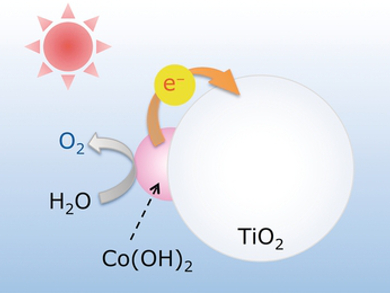Water oxidation to form molecular oxygen involves a complicated four-electron process and is a crucial step in artificial photosynthesis to produce fuels using solar energy. From the viewpoint of solar energy conversion, a photosystem that is cheap and stable, and functions under a wide range of visible light would be necessary.
Kazuhiko Maeda, Tokyo Institute of Technology, Japan, and colleagues have developed a new powdered photocatalyst consisting of cobalt hydroxide and titanium dioxide. It is well known that titanium dioxide is an active photocatalyst, but only works under UV irradiation. In contrast, this hybrid photocatalyst is capable of harvesting visible light with wavelengths of up to 850 nm to oxidize water into oxygen gas. It consists only of earth-abundant elements.
The researchers predict that the cobalt/titanium-based photocatalyst could be applicable to the water oxidation half-cycle in artificial photosynthetic schemes such as water splitting and the fixation of carbon dioxide.
- Modification of Wide-Band-Gap Oxide Semiconductors with Cobalt Hydroxide Nanoclusters for Visible-Light Water Oxidation,
Kazuhiko Maeda, Koki Ishimaki, Yuki Tokunaga, Daling Lu, Miharu Eguchi,
Angew. Chem. Int. Ed. 2016, 55, 8309–8313.
DOI: 10.1002/anie.201602764




